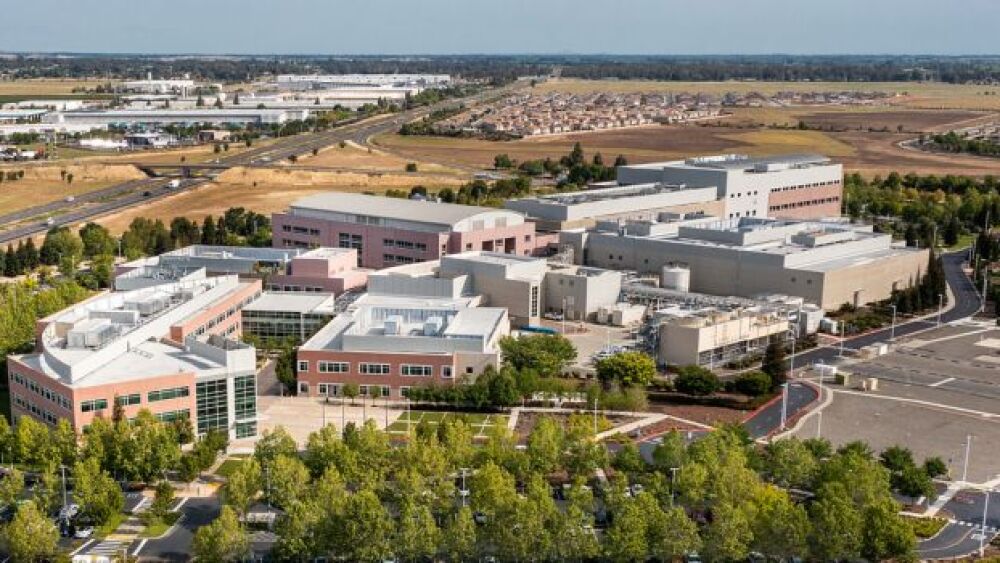The Swiss contract manufacturer’s cash deal for Roche’s facility in Vacaville, California, is one of the world’s largest manufacturing sites for biologics—a major growth driver for Lonza and other CDMOs.
Pictured: Roche manufacturing site in Vacaville, California, purchased by Lonza/courtesy of Roche
Last week, Swiss contract manufacturer Lonza announced it was paying $1.2 billion to buy a Roche manufacturing facility in Vacaville, California. The deal is meant to boost Lonza’s production of commercial mammalian products, which are made from cells isolated from animal tissues, and to expand its U.S. manufacturing footprint. The acquisition is indicative of the growing reliance of biopharma companies on contract manufacturers for biologics, experts told BioSpace.
The all-cash deal secures for Lonza one of the world’s largest biologics manufacturing facilities by volume, according to the company, specifically increasing its large-scale production capacity for mammalian therapies as biopharma companies look to outsource these complex biologics.
Jean-Christophe Hyvert, president of biologics at Lonza, told BioSpace in an emailed statement that the Vacaville site adds “significant” new capacity to its network to support the growing global need for large-scale mammalian manufacturing and gives the company a more substantial presence on the West Coast of the U.S. near biotech hubs.
Hyvert noted that the site was a “valuable strategic proposition” for the manufacturer as “capacity utilization” is high in the mammalian business.
“We have a healthy pipeline of molecules across phases, and we had already identified a need to secure more capacity to meet growing customer needs and sustained high demand for large-scale commercial manufacturing,” Hyvert said.
Like other contract development and manufacturing organizations (CDMOs), Lonza’s biologics business continues to be a major growth driver. Between 2024 and 2028, the Swiss CDMO anticipates a sales compound annual growth rate (CAGR) in the mid-teens for biologics, with a focus on mammalian, microbial, bioconjugation, mRNA and drug product services.
The Vacaville deal between Lonza and Roche is expected to close in the second half of 2024. Following the closing, the site will be integrated into Lonza’s biologics division, joining a network of existing mammalian manufacturing sites in Visp, Switzerland; Slough, England; Portsmouth, New Hampshire; Porriño, Spain, and Singapore.
“It will build upon our reputation as one of the world’s leading providers of high-quality manufacturing services for large-scale mammalian,” Hyvert said. “The Vacaville facility will complement our existing biologics sites on the East Coast, in Portsmouth, as well as our international network in Europe and Asia.”
Big Money, Big Facility
According to market research firm Nova One Advisor, CDMOs like Lonza and Charles River are making significant investments in the expansion of their mammalian cell culture manufacturing facilities for their respective biologics businesses, as mammalian-based biopharma contract manufacturing continues to capture the largest market share.
The Vacaville site belonged to Genentech from 2000 until 2009, when Roche acquired the company. However, in 2023, Roche announced it would be divesting the facility. Under last week’s acquisition, Lonza will offer employment to approximately 750 existing employees at the Vacaville site.
The site has a bioreactor capacity of 330,000 liters and has been approved for production by the FDA and EMA. Roche products that are currently manufactured in Vacaville—which were not disclosed—will be supplied by Lonza “with committed volumes over the medium term, phasing out as the site transitions to serve alternative customers.”
Lonza also plans to invest over $556 million to enhance the next-generation mammalian biologics capabilities at the site, according to the company.
William Blair analyst Max Smock is bullish on Lonza’s deal, adding that he is “optimistic” about mammalian manufacturing.
“We had hoped that maybe [Lonza would be] pushing a little bit more aggressively into that drug product space,” Smock told BioSpace. “That’s been a piece where we’ve been a little bit frustrated, and so to see them come out and make a big push into the space that I think is their kind of core competency within the biologics segment was, I thought, super encouraging.”
According to a report from Straits Research, the global biologics market is estimated to grow to $506 billion by 2030, with the mammalian sector expected to rise to $182 billion.
Smock added that the new Lonza facility can potentially produce between $1.6 billion and $2 billion in annual revenue. He said the mammalian biologics sector is poised to grow by “double digits” and presents an excellent opportunity for Lonza.
However, for 2024, Lonza is projecting flat sales as CDMOs look to a slow recovery from last year’s headwinds.
Gil Roth, president of the Pharma & Biopharma Outsourcing Association, told BioSpace he sees Lonza’s Vacaville deal as a “sign of faith” in the strength of the biomanufacturing and CDMO sector as well as a positive indication of the strength of the U.S. market.
Roth noted that in the wider CDMO industry there is “optimism” that more funding for later-stage manufacturing is starting to flow back to contract manufacturers. However, the industry is still waiting to see sustained signs that early-stage biopharma R&D funding is back.
Smock said that while the Lonza-Roche deal shows some momentum returning to the CMDO market after 2023’s headwinds in the sector, it may not be a full recovery as preclinical activity has not fully returned.
“Lonza is not baking in a broader recovery on the early-stage stuff; the opportunity with Lonza and why we liked the story is that the commercial piece, which is the vast majority of their revenue today, that piece continues to be very strong,” Smock said. “And expectations for preclinical and earlier stages have bottomed. I don’t know if we’re necessarily back to where that piece will pick up here in the near term, but it feels like we’re moving in that direction.”
Tyler Patchen is a staff writer at BioSpace. You can reach him at tyler.patchen@biospace.com. Follow him on LinkedIn.
Editor’s note (March 29): This story has been updated with information on the growth of the biologics sector from Straits Research.






